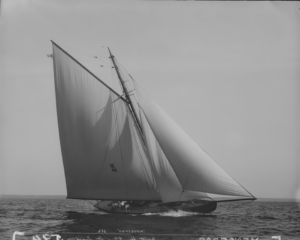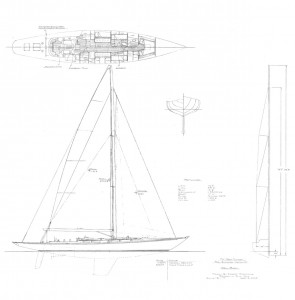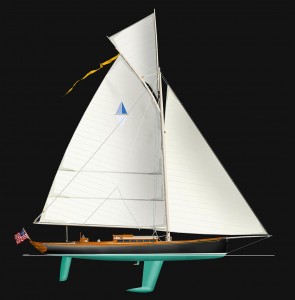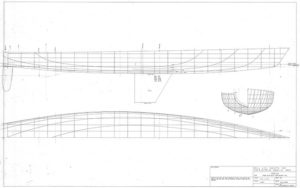
This year, nearly 300 boats will race in the Chicago-Mac classic. But how many tell the design story of the truly great race winners, like this 1904 champ Vencedor?
It might be mid-April, but that hasn’t stopped thousands of fresh water sailors from booking up their July-21st weekend. That’s when the Chicago-Mac race — or more precisely, the “Chicago Yacht Club Race to Mackinac” — fires off for 2018. And true to form, this year’s 333-mile granddaddy of all freshwater distance races will see a full flush of raceboats shaping up at the starting line.
So far, we counted 292 vessels in the 2018 scratch sheet. Wednesday night ’round-the-can racing, the Mac is not.
Of course, to our twisted-boat design sense of fun, a more rigorous all-around boat test would be the Chicago to Thunder Bay Race. That would bolt a tricky passage though Michigan’s Sault St. Marie and followed by a seriously nasty 263-mile crossing of Lake Superior, deep into remote western Ontario. If you want a sense of just how stiff a test that race might be, spin through this list of Great Lakes shipwrecks. And count the number of vessels that flat “broke in half” up in these waters.
It’s gory, but true: That is the kind of sailing challenge that would spark some serious design innovation.
Where’s the Great “Mac Race” Racer?
But what’s actually striking, from a design perspective about this year’s Mac Race, is how little a design perspective this race has. Considering the Mac has been run basically continuously since 1898, and The Island Goat Sailing Society alone claims that its nearly 300 members have logged 12,242 years (!) of Mac Racing, it’s striking to see that no clear design narrative has emerged for this event. Sure, there are plenty of J-Boats, Beneteaus, Farrs and other great boats that make this great run. But those boats race everywhere. There are no IMOCA 60 or Mini-Transat designs that define this great race. Nor are there many storied vessels, like the Newport-to-Bermuda’s Dorade or the TransPac’s legendary Cal 40.
So, to get the conversation started about what the design idiom for a great Mac Racer might be, we poked around this year’s competitors and came up with a couple of design themes. And sketched up a couple of ideas.
Let’s have some Great Mac Racer design fun.
Idea One: The Spirit-of-Tradition Lake Sled.
Any random walk through this year’s Chicago-Mac Race fleet pretty comes to a halt when the west coast racing sled Merlin comes into view. This incredibly-storied, incredibly-light 67-footer, was Bill Lee’s prototype version of his popular, slightly larger, Santa Cruz 70. And Merlin is what every designer loves about Mr. Lee’s boats.
How he married the value of simplicity with working within a budget.
Back in 1976 when Merlin hit the water, Lee is quoted as saying the entire boat and race prep cost only $150,000. And that was for a TransPac record-breaking vessel. The same feat would easily run millions today. Lee knew how to keep his boats thin, light and easy to sail. And that is the way to race the Mac, to this day.
The only problem with Merlin, she’s a bit tender for any sort of all-around windward work. So our take on a modern Mac racer/cruiser would have to go to windward, to be more reasonable to cruise. We would start with a design like Goshawk, our 76-foot racer/cruiser that was so successful in the Bermuda Race. We would reboot Merlin to feature long overhangs, fore and aft, to celebrate the classic Mac schooners that raced at turn of the century.

The ideal Spirit-of-Tradition Mac Racer would combine the lightness of a “Merlin,” with more windward punch and traditional schooner lines, to make something like “Goshawk.”
We would harvest serious modern performance with slick underwater foils and a low-wetted surface hull, tweaked to handle the bad-breaking big lake seas. And to keep costs down, we would also experiment with the right balance of wood, foam and carbon to make the boat affordable, yet light and stiff. We probably would add some free-board to keep the boat dryer and open up space below. Race or cruise, if you are going to build to 75-plus feet, you should least enjoy all that room.
But here is the trick with any Spirit-of-Tradition racer: Finding the right build and sail package that rates sensibly under the ORR rule that defines the Mac handicapped fleet. But that is not as complex as it sounds.
All that is needed is some common sense and a sense for the design idioms of Great Lakes Race boats. And a fast, light — yet historically relevant — Mac winner is absolutely possible
Idea Two: Lots of History, Lots for Crew to Do.
Guess which stat is the most eye-popping in terms of design criteria in the Chicago-Mac Race? Number of boats? Number of retirements? Number of pounds of fudge consumed? Nope. It is the number of crew per boat. In vessel after vessel, easily 10 people are willing to give up their weekends and crowd onto boats made for far fewer people. For example, the Volvo 70 Il Mostro, is supposedly taking 18! That’s a lot of lunches.
So we thought, why not delve deeply into the Chicago-Mac design archive and find some local sailing vernacular for all this crew to do? Turns out, starting back in 1904, schooners were the lake speedsters of their day. And the yachts like Valmore, Vennena, and Vancedor all featured massive fore-and-aft running sails, crazy-long bowsprits and serious topsails.
All of which make perfect work projects for crews on a long 333-mile overnight race.

Today’s Great Lakes technology meets throwback sandbagger, a 53-foot racer speaks directly to the glories of Mac racing schooners of years gone by.
What’s fun, is how easy it is to update this chunk of big lake history into a functioning modern/classic Mac racer. Like this topsail speedster we sketched up called Beaujolais.
This is the way to do Mac Race with lots of crew! 45 feet of waterline, 53 feet of over-all length, and the 65 feet of bowsprit-to-boomkin length, when the 12-or-so-foot composite bowsprit is baked in. But what gives this bit of modernized lake history some serious balls, is the 15-foot beam and an ultra-light, oh-so-modern surfing hull that flashes 10 feet of draft! Basically, this is a fresh water Civil War sandbagger, a la Precept and Tatler, but updated for serious off-shore work. All of which would keep a rated sail plan of about 850 square feet stiff in all conditions.
And that leaves out the unrated flashy jackyard topsail or the honkin’ off-the wind spinnakers.
Honestly, we just laugh at the speed potential of this thing if several were built and raced well, as a level class with no handicap rule. In the right hands, this boat would be surprisingly seaworthy in even the worst weather. And in terms of pace, let’s just say, there would be plenty of “serious comments” from all the other owners. That is, until they raced one.
But you get our point: It is the !@#$ing Chicago-Mac race– style points absolutely should matter.
